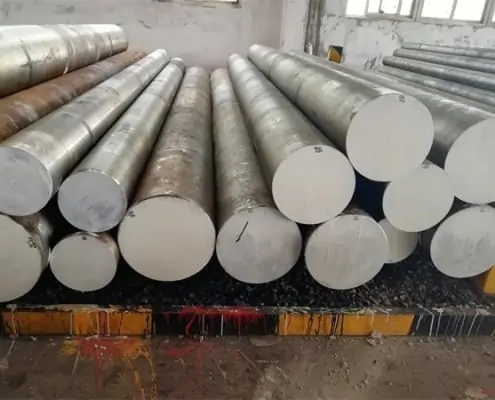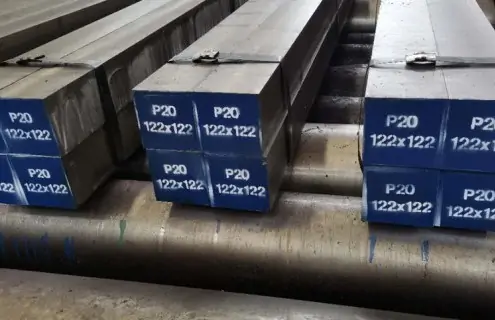D2 STEEL BUYING GUIDE
In finding the best and the highest quality of D2 steel, it’ll require you to know too few information about it. For today’s guide, we’ll be walking you through all of the relevant and the important information about D2 steel so that it’ll be easy and simple for you to choose and pick out the best in the market!
CONTENTS OF D2 STEEL
It’s part of the D family of steels, which means that they contain substantially higher levels of chromium and carbon.
Image of piled up D2 steel ready for distribution
In the family, the steels run from D2 up to D7, and D2 steel is a type of steel that quite lower levels of chromium and carbon compared to other D steels. The following are the elements present in D2 steel:
| Element or Substance | Content Percentage |
| Carbon (C) | 1.40 to 1.60% |
| Manganese (Mn) | 0.60 % |
| Silicon (Si) | 0.60% |
| Cobalt (Co) | 1.00% |
| Chromium (Cr) | 11.00 to 13.00% |
| Molybdenum (Mo) | 0.70 to 1.20% |
| Vanadium (V) | 1.10% |
| Phosphorus (P) | 0.03% |
| Nickel (Ni) | 0.30% |
| Copper (Cu) | 0.25% |
| Sulfur (S) | 0.03% |
These are the usual and the common contents of D2 steel; and they’re based off of a standard.
ORIGIN OF D2 STEEL
The first ever evidence of D2 steel existence dates back in World War II (WWII). They were initially used to create production line dies, it’s used to work on, cut, and shape other and softer types of steel. You can think of D2 steel as a type of steel that was designed and engineered to create and form out parts and components in the military and the aviation sector. The thing that manufacturers loved about D2 steel isn’t its capacity to cut through softer steel alone, but the fact that it can yield consistent results after multiple times and attempts. From this alone, we’re already welcomed by the strength and the toughness of D2 steel.
WHAT IS THE HARDNESS OF D2 STEEL?
In a regular setting, D2 steel’s hardness can reach up to 64 HRC from 55 HRC at tempering. %20100vw,%20800px%E2%80%9D%20data-lazy-src=%E2%80%9Dhttps://waldunsteel.com/wp-content/uploads/2021/03/What-is-the-Hardness-of-D2-Steel_.webp%E2%80%9D%20/>%C2%A0D2%20steel%20is%20hard%20but%20is%20not%20as%20brittle%20as%20its%20counterparts%20The%20strength%20that%20it%20translates%20to%20sits%20at%20about%20275%20ksi%20to%20320%20ksi%20when%20the%20hardness%20rises%20and%20increases.%20Unlike%C2%A0<a%20href=) M42 HSS that has hardness levels that can go as high as 70 HRC, and EN41B steel that can reach hardness levels between 68 to 70 HRC, D2 steel isn’t as hard but is not as brittle as these types of steel.
M42 HSS that has hardness levels that can go as high as 70 HRC, and EN41B steel that can reach hardness levels between 68 to 70 HRC, D2 steel isn’t as hard but is not as brittle as these types of steel.
IS D2 STEEL BETTER THAN S30V?
S30V is a type of stainless steel that’s both corrosion and wear resistant. More often than not, it is the type of steel that’s compared to D2 steel because they have almost the same properties. 
Sharpness
Choosing either of the two (2) can help you if you’re aiming for sharpness. Both D2 steel and S30V steel are capable of cutting or slicing through softer metals and other materials. The slight difference that the S30V steel can attain a level that’s sharper than D2 steel. However, D2 steel is easier and more workable when it comes to sharpening.
Hard Use
S30V is known to be a type of steel that’s more wear and corrosion resistant than D2. So, if you are to subject both in hard use, you can expect S30V steel to last longer and to be more effective by a shy difference.
Brittleness
While D2 steel can reach a hardness level that can go as high as 64 HRC, it isn’t as brittle and as fragile as S30V. D2 steel also has exemplary levels of edge retention, so, the toughness and the strength is retained even if the blade is large. For S30V, though, if the blade or the unit is large, it’ll be more brittle and worse.
Hardness
When it comes to hardness S30V will take the W. In working with metals, S30V will be chipped less than D2 because of the toughness that it possesses.
DOES D2 STEEL MAKE A GOOD KNIFE?
Yes, you can use D2 steel to create a high quality and a sharp knife. It’ll give you the sharpness that you’re not able to find with other types of steel.
%20100vw,%20721px%E2%80%9D%20data-lazy-src=%E2%80%9Dhttps://waldunsteel.com/wp-content/uploads/2021/03/Does-D2-Steel-Make-a-Good-Knife_-.webp%E2%80%9D%20/></p>%0A<p>An%20example%20of%20a%20D2%20steel%20knife</p>%0A<h2><span%20id=) WHAT CAN YOU USE D2 STEEL FOR?
WHAT CAN YOU USE D2 STEEL FOR?
Some of the most typical applications you can use D2 steel for include, but are not limited to:
- Heading Tools
- Gauges
- Cutters and Slitters
- Forming and Punching Dies
- Blanking and Coining Dies
- Edging Rollers
- Shredders
- And Many More!
You can experiment on the application you can have based on the properties and the characteristics of D2 steel!
WHAT ARE THE SCIENTIFIC PROPERTIES OF D2 STEEL
Here are some of the Scientific properties of D2 steel that are worth noting:
- Classified as high-carbon and high-chromium steels
- Excellent sliding contact resistance, abrasive resistance, and overall wear resistance
- High chromium content provides high quality corrosion resistance
DOES D2 STEEL RUST?
Yes, the chromium and carbon content that it has is not enough to prevent it from staining and from rusting.
Image of a stained and a rusted D2 steel knife
As a matter of fact, if you place and compare D2 blade to other types of stainless blades in the market, it’ll rust and be stained quicker and faster. However, you can prolong the freshness and the efficiency of D2 steel if you properly care for it. Meaning, you’ll perform all necessary procedures and methodologies to keep it at its best state!
WHAT IS DIN 5401?
DIN 5401 is the German standard that covers DIN steels. The “D” in DIN stands for Deutsch (German), and the “N” stands for Normaal (normal). This standard includes chemical and mechanical properties, as well as hardness values.
WHAT IS DIN 1480?
DIN1480 is another German standard which covers DIN steels. The “D” in DIN stands for Deutsch (German), and the “N” stands for Normaal (normal). This standard includes chemical and mechanical properties, as well as hardness values.
HOW DO YOU MEASURE DIN STEELS?
DIN Density is measured in grams per cubic centimeter (g/cm³). DIN Hardness is measured with Brinell, Rockwell (HR), or Vickers (HV) scales. Most of the DIN steel series are classified using HRC hardness scales.
WHAT DOES DIN STAND FOR?
DIN stands for DIN Deutsch (German), and DIN steels are German-made steels.
WHAT IS THE DIFFERENCE BETWEEN DIN 5401 AND DIN 1480?
The main difference between DIN5401 and DIN1480 is that DIN5401 includes chemical properties, while DIN1480 does not. DIN5401 also includes hardness values, while DIN1480 does not.
WHAT IS THE DIFFERENCE BETWEEN DIN AND AISI/SAE?
The main difference between DIN and AISI/SAE is that DIN steels are made in Germany, while AISI/SAE steels are made in the United States. DIN steels are also classified using the HRC hardness scale, while AISI/SAE steels use the Rockwell C (RC) hardness scale.
WHAT CAN D2 STEEL BE USED ON?
D DIN steels can be used on a variety of cutting devices, including knives and tools. DIN steels are found in the tooling industry, where they are usually heat treated for this specific purpose.
HOW DOES D2 STEEL COMPARE TO OTHER STEELS?
DIN steel is tougher and holds an edge longer than most other steels. D DIN steel has a high carbon content, which makes it extremely tough. D DIN steels are also capable of taking the sharpest edges possible through heat treatment.
GET HIGH QUALITY D2 STEEL WITHOUT SPENDING A FORTUNE!
The best and the most trusted Chinese D2 steel manufacturer is none other than us here at Waldun Steel. Apart from having the most talented and the most sought after experts, we’re also equipped with the most advanced tools and materials! Never in our experience did we fail to provide our clients with quality D2 steel they need!
OTHER RELATED STEEL PRODUCTS
Page Contents
- D2 STEEL BUYING GUIDE
- CONTENTS OF D2 STEEL
- ORIGIN OF D2 STEEL
- WHAT IS THE HARDNESS OF D2 STEEL?
- IS D2 STEEL BETTER THAN S30V?
- DOES D2 STEEL MAKE A GOOD KNIFE?
- WHAT CAN YOU USE D2 STEEL FOR?
- WHAT ARE THE SCIENTIFIC PROPERTIES OF D2 STEEL
- DOES D2 STEEL RUST?
- WHAT IS DIN 5401?
- WHAT IS DIN 1480?
- HOW DO YOU MEASURE DIN STEELS?
- WHAT DOES DIN STAND FOR?
- WHAT IS THE DIFFERENCE BETWEEN DIN 5401 AND DIN 1480?
- WHAT IS THE DIFFERENCE BETWEEN DIN AND AISI/SAE?
- WHAT CAN D2 STEEL BE USED ON?
- HOW DOES D2 STEEL COMPARE TO OTHER STEELS?
- GET HIGH QUALITY D2 STEEL WITHOUT SPENDING A FORTUNE!
- OTHER RELATED STEEL PRODUCTS











